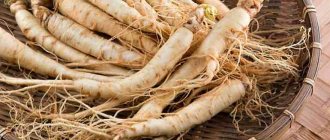The prickly shrub barberry grows in almost all climatic zones, on all continents, with the exception of Australia. It is most common in the mountainous regions of the Northern Hemisphere. The ripe fruits of the shrub are oblong in shape, reaching up to 20 mm, and have a pronounced sour taste. It is noteworthy that all parts of this unsightly shrub contain a lot of useful substances. Barberry can rightfully be called a kind of repository of many vitamins, essential oils, organic acids, alkaloids, and other elements beneficial to human health.
The healing qualities of this plant have been known since ancient times; medicines from the berries, leaves, bark and even roots of the bush were made in Ancient Egypt, Assyria, Babylon and India. Due to its taste, barberry is widely used in cooking. Various seasonings are made from barberry berries for barbecue and other meat dishes, they are added to horseradish, tinctures, juices, jellies, jams, mousses, marmalades, etc. are made.
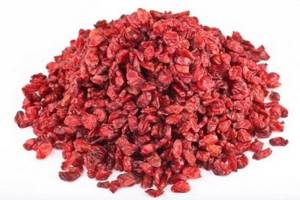
Barberry red
In Central Asia, barberry is primarily known as an indispensable seasoning for traditional pilaf. It is known that various spices are present in various recipes for oriental pilaf. You can add this or that seasoning to the dish according to your taste; a lot here depends on the preferences of the cook. However, three types of spices - cumin, saffron and barberry - are mandatory ingredients in almost all Uzbek pilaf recipes.
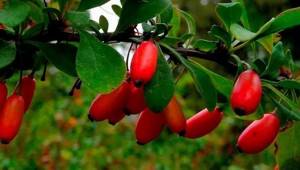
Dried black or bright red barberry berries, rich in vitamin C, add a piquant taste and natural sourness to the dish. It is recommended to store barberry for pilaf in the form of whole dried berries - the flavor is better preserved in whole fruits. In some pilaf recipes, to maximize the taste, it is recommended to add barberry in crushed form.
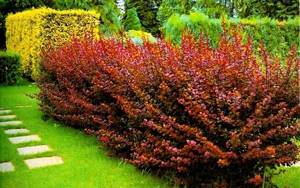
As a rule, barberry, among other spices, is added to zirvak. After frying onions, meat and carrots. At this stage, add salt and garlic to the cauldron. After this comes the turn of spices. You can add barberry to pilaf together with rice, in this case the berries will steam well and their pleasant aroma and piquant sourness will be more pronounced in the pilaf.
Barberry (spice for pilaf), video
Real oriental pilaf with barberry is a work of culinary art. Cooks say that without seasoning it is just porridge with meat, and among the spices, dried sour berries are one of the most important. The purpose of dried berries is to impart a subtle flavor, to “ennoble” the pilaf, which, according to the canons, should be cooked with a large amount of fat. The use of this spice improves digestion and eliminates the feeling of heaviness in the stomach, which is usually present after fatty foods.
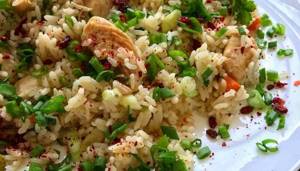
Features of pilaf with barberry
Barberry berries have been used in the cooking of Eastern and Asian countries since ancient times: this spice combined gastronomic value with the ability to heal. Therefore, everything that is prepared with this spice is not only tasty, but also very healthy.
Barberry is not used as often in cooking in temperate latitudes as in the Caucasus and Asia. If they cook, it’s mainly drinks and jam, some desserts. For us, dried barberry berries are more of an exotic addition that you can safely do without. But if at least once you cook not just rice with meat, onions and carrots, but a luxurious dish with spicy notes and a subtle aroma of spices, it will be impossible to return to the past.
What seasoning is needed for yellow pilaf?
White pilaf is more like porridge, so all housewives strive to get a golden yellow dish.
As you understand, rice itself is white. To achieve a beautiful bright yellow color you need to use the following ingredients:
- Turmeric . This spice can also be found under the name turmeric. Turmeric can also be seen under the name “Indian saffron”; by the way, turmeric has nothing in common with this spice. Saffron is nothing but the dried stigmas of crocus flowers, while turmeric is the rhizomes of a herbaceous plant. Turmeric perfectly colors pilaf a bright yellow color.
Sunny Seasoning for Yellow Rice
- A seasoning called curry also tends to turn rice yellow. However, not everyone likes the taste of this spice, so when adding it, take into account the taste preferences of those for whom you are cooking.
- If you are the lucky owner of saffron , then you can add it as a natural dye. However, if the saffron is real, then you need to add very little of it.
- Oddly enough, carrots add not only a sweet taste to pilaf, but also a slightly yellowish color.
Cooking pilaf with barberry
If the East is a delicate matter, then oriental cooking is doubly subtle. Here the final result depends on seemingly insignificant nuances and details. Eastern chefs master this art of jewelry to perfection, since half the success of a dish (including rice with meat) is the correct use of spices. The specificity of their use is such that the quantity must be precisely adjusted: spices are a very potent ingredient, it can affect not only the taste of food, but also the health of the eater.
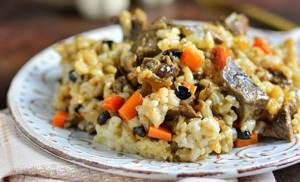
The recipe for pilaf can vary depending on the ingredients. The eastern one is prepared only with lamb, and this requires more seasonings. This softens the specific taste of this meat and especially of fat tail fat, which is used as fat. But there are other options - for example, a lighter one with chicken or even a vegetarian version, with vegetable oil and only vegetables. Here you need much less dried berries, otherwise the dish will become acidic.
How to prepare seasoning for pilaf at home, with your own hands
So, knowing the classic composition of seasoning for pilaf, you can try to prepare it yourself, after carefully studying the exact proportions. What rules should be followed when handling spices so that they highlight the taste of pilaf without spoiling it?
Various recipes call for the use of whole or crushed spices. However, the main rule is always the same: spices for preparing seasonings should always be fresh. When purchasing ingredients for homemade seasoning, you should pay attention to the packaging: it is advisable to give preference to glass or foil, but not paper. The highest quality and freshest spices are sold in glass jars, most of them have a built-in grinder. Thus, by purchasing the ingredients for seasoning in glass, they can be ground immediately before cooking, which will certainly benefit the taste of the pilaf. However, it is worth remembering that only herbs are crushed to make homemade seasoning, but it is better to leave the berries whole.
The ingredients for preparing the seasoning can be varied, but several ingredients always remain the same: - cumin, which gives the dish a subtle, characteristic oriental aroma; - barberry, which has a characteristic sourness; - saffron, thanks to which pilaf acquires a beautiful yellow color.
It should be remembered that the resulting seasoning should be added to the dish carefully so as not to interrupt the taste of the pilaf. When preparing pilaf, experienced chefs advise not to mix the seasoning components with each other, but to add them to the dish separately at different moments of cooking. At the same time, spices are added not to the pilaf itself, but to the zirvak - those components that are cooked in a cauldron before the rice is thrown in (this could be, depending on the recipe, meat, onions, carrots and other products). Zirvak is the basis of the dish, and the taste of the finished pilaf depends on how correctly it is prepared and what spices were chosen. If the spice mixture is already ready, it is advisable to add it to the pilaf 20-30 minutes before it is ready, when all the water has almost been absorbed.
Delicious recipe! Simple dough for nuts

The most important rule to remember when preparing seasoning for pilaf is moderation and precise proportions. Let's give an example of the classic composition of spices used to prepare pilaf (1 large cauldron).
- a small pinch of saffron (can be replaced with half a teaspoon of turmeric);
- half a teaspoon of paprika;
- 10 barberries;
- a head of fresh garlic, divided into cloves;
- a mixture of ground red and black pepper (to taste, but not more than half a teaspoon);
- a pinch of cumin;
- salt to taste.
To prepare pork pilaf, you can also add ground sweet paprika and dried tomatoes to the seasoning. The taste of beef in the dish is emphasized by dried herbs: basil, marjoram, cumin. If you want to prepare a dish that is close to the European rather than the Oriental version, you can supplement the traditional composition of the seasoning with mustard seeds, cloves and nutmeg.
If some ingredients are not available in the kitchen or store, some of them can be replaced: for example, saffron is similar in its properties to turmeric, cumin can be successfully replaced by cumin, and instead of barberry, the taste of pilaf will be perfectly emphasized by raisins or dried cranberries. However, it should be remembered that you cannot completely replace the seasoning for pilaf with another (for example, use seasoning for rice) - the end result will be a completely different dish, far from the concept of “pilaf”.
If you don’t have time, you can also buy ready-made seasoning, which is produced by many manufacturers today. When choosing in this case, you should focus on the pilaf recipe, since different ingredients (pork, chicken, lamb) require a different set of spices.

When and how much to add barberry to pilaf
It is important to know when to add barberry to pilaf. The extent to which it imparts its taste and aroma to the dish depends on this. In the classic version, it is customary to add all the spices to the zirvak when it is almost ready. Zirvak is a mixture of fried meat with onions and carrots, a base on which rice is placed. When to add barberry: last, often adding a little water to the frying with vegetables first - so that the spice “straightens out” already at this stage.
How many barberry berries you can take depends on the meat. For lamb you will need a tablespoon per 1 kg of pilaf (zirvak and rice in a 1:1 ratio). Beef pilaf with the same quantity and ratio of parts is seasoned with a teaspoon of barberry.
How to replace sour berries if there is no barberry?
Other sour berries that you can find in the kitchen. It could be cranberries, prunes, cherry plums, etc. Although many believe that it is better not to replace this spice with anything.
Use in cooking
Barberry gives dishes a delicate taste with sourness. Barberry fruits are placed in a dish during cooking, or added at the end of cooking, or served separately with the finished dish.
Barberry fruits are an indispensable component of pilaf. Fresh or dried berries are added to soups to add a sour taste. Young barberry leaves are used instead of sorrel to make green cabbage soup. They can be stored during the flowering period and dried in the open air. Fresh leaves can be eaten in salads, and also added to marinades, when sauerkraut.
Barberry berries are used to make jam, prepare delicious jellies, juices, syrups, kvass, sherbet, and also add berries to savory sauces to add a pleasant sourness. Barberry berries are widely used in the confectionery industry for baking pies, muffins, cookies, and buns.
Berries and leaves of barberry are brewed into tea. Barberry juice quenches thirst well and stimulates appetite. In addition, it is a useful vitamin supplement and excellent prevention of kidney, liver and urinary tract diseases.
Drying barberry berries is easy at home. To do this, the berries are washed and dried in a dehydrator at a low temperature, no more than 40 degrees.
Pilaf with chicken and barberry
In order to prepare a lighter version - pilaf with chicken - we will need 700 g of rice and chicken meat (it is better to cut it from the thighs), and in addition:
- Onions (2 pcs.).
- Carrots (3 pcs.).
- A glass of refined vegetable oil.
- Zira, turmeric and barberry (a teaspoon each).
- Ground salt and pepper to taste.
Cut the peeled onions and carrots into half rings and semicircles, and cut the meat into pieces. Heat the oil in a cast iron pan, throw in the meat, then the onions, then the carrots. As soon as the onions turn white, it’s time to add spices, salt and pepper. The zirvak is simmered for 20 minutes, after which we pour the rice on top and fill it with water to cover the finger. Let it boil, turn the heat down to low and cook under the lid until the rice has absorbed all the moisture. When the fire is turned off, you need to let the pilaf stand for at least half an hour under the lid for it to finish cooking.
Spices for pilaf with chicken meat
For such pilaf, not many seasonings are used, but they still add excellent taste to the dish and are good for health. The dish receives many vitamins (PP, H, B, E) and minerals (iron, magnesium, zinc, potassium, calcium, selenium, ß-carotene).
Set of herbs for pilaf with chicken:
- dried, chopped chili and red paprika;
- cumin seeds;
- fresh/dried parsley;
- black pepper;
- barberry berries;
- thyme;
- dried/fresh garlic;
- saffron (turmeric).

Do not overdo it with the amount of seasonings; add each one separately at different stages of cooking. Dry, ground herbs are added to zirvak - this is the stage of cooking pilaf, when vegetables and meat are cooked in a cauldron, but the cereal part has not yet been added. The final taste of the dish depends on the correct preparation of zirvak and the mixture of seasonings. Add the prepared seasoning mixture 20 minutes before the end of cooking.
Pilaf with barberry in a slow cooker
Few people can light a fire and put a cauldron on it to cook food. In our kitchen there is a stove, gas or electric, for this purpose. But more and more often, housewives are starting to use a multicooker for this - a universal kitchen gadget, the possibilities of which are truly unlimited.
To prepare pilaf with barberry in a slow cooker, take:
- 500 g of brown rice (it is the most valuable, unpolished).
- 500 g pork (pulp with fatty layers).
- 500 g carrots.
- 300-350 g onions.
- A head of garlic.
- A tablespoon of barberry.
- 100 ml vegetable oil.
- Salt, ground pepper, seasoning for pilaf.
Spices that improve the taste of pilaf
It’s worth trying to cook pilaf with cumin to experience the whole huge range of flavor notes of rice with this seasoning. In addition to cumin, culinary experts recommend adding to rice:
- coriander;
- barberry;
- saffron;
- turmeric;
- capsicum;
- garlic.
All spices are mixed together. Coriander is used in the form of seeds or powder; the spice gives the pilaf a pronounced aroma. The addition of barberry adds a certain sourness to rice and meat. Dried barberry fruits are placed in pilaf.
Expensive saffron can be replaced with turmeric powder. These spices are recommended to be added to pilaf with beef or pork. Spices give a rich, bright taste to the dish and reveal their aroma during the cooking process.
Garlic is an invariable ingredient in pilaf. There is hardly a cook in the world who prepares a dish without adding garlic. Even one clove imbues rice with special flavor notes, and in combination with cumin, the taste qualities of garlic are revealed to the maximum.
Video recipe for homemade lamb pilaf with barberry
The video shows step by step how to prepare this dish with lamb, in particular, the chef tells you when to put barberries in pilaf. All the ingredients from this recipe are available, so it won’t be difficult to prepare a flavorful, hearty lunch immediately after this video tutorial.
Was this information useful to you? Like ♥ and subscribe to our channel!
Do you have anything to say on the topic? Write in the comments!
How many housewives there are, so many variations of pilaf. Recipes differ in ingredients, their proportions and set of spices. But most chefs agree that pilaf with barberry is the most appetizing, since this berry gives it a special aroma and taste.

What is included in pilaf seasoning?
In order to understand exactly what ingredients are included in the seasoning for pilaf, you need to understand what the pilaf itself is like. Don’t be surprised, because in fact there are a lot of variations in the preparation of this dish.
So, it must be said that pilaf can be prepared from:
- Chicken
- Pork
- Lamb
- Beef
- Turkeys
- Fish
It becomes clear that when using different meats, you need to choose different spices for the dish. Pilaf can also be “sweet”; dried apricots and prunes are added to it. In this case, the list of spices will also be different.
When to add barberry to pilaf?
One of the main components of preparing good pilaf is a cast-iron cauldron with thick walls. But if you don’t have it, you can use an aluminum vessel. The main thing is that it is durable and well-calcined. As for barberry fruits, it is preferable to use black ones. Red dried berries are also good, because they also have a pleasant sourness.
During cooking, you need to know when to add barberry to pilaf. This ingredient complements zirvak (i.e. base for pilaf), which consists of meat and vegetables. The chopped onions are fried in a sufficient amount of very hot oil. Then the carrots are fried, cut into slices or grated. Fried vegetables are seasoned with spices and water is added. When it boils, it’s the barberry’s turn. The substance is salted and supplemented with garlic paste. Then the zirvak is stewed for about 40 minutes. After this, it's time to add the washed rice.
LiveInternetLiveInternet
Proper preparation of pilaf at home is quite difficult. Not everyone has a cauldron, and not everyone can afford to cook in the fresh air. But still…
(You can skip this long introduction and immediately start viewing and preparing the recipe for pilaf, in which EVERYTHING IS CLEAR. However, the introduction describes important details about real pilaf, which will certainly come in handy...)
When the conversation turns to pilaf, almost everyone has in mind the Uzbek version of this dish. Despite the fact that there are quite a few varieties of pilaf, the Uzbek one is still considered the most, real, correct, and authentic. This is the same pilaf that is laid out in a heap on a large dish, large pieces of meat are laid out around it, and in the center there is a head of garlic, stewed right in the husk. This pilaf is so crumbly, aromatic, and has a bright sunny color. And the most amazing thing is that it does not require a large set of products, but it does require some knowledge...
The most important part of preparing Uzbek, or more precisely, Fergana pilaf is the choice of rice. So, rice called dev-jeera
.
growing in the Fergana Valley. This rice is firm, low in starch, and able to absorb a lot of water and oil while remaining fluffy. Also suitable are varieties of rice such as chungara, dastar-saryk, kora-koltak, bugday-gurunch, arpa-sholi, konilig
. But there is a high probability that you will not be able to find such rice, then choose Spanish varieties of rice “for paella”. If they are not there, basmati remains - this is wrong, but still better than “Krasnodar” or “for risotto”. Basmati is a relatively non-starchy rice. The only caveat is that it cooks much faster than the “pilaf” varieties - only 10 minutes. Rice varieties that contain a lot of starch are absolutely not suitable for preparing pilaf - with them the pilaf will never turn out crumbly. Before preparing pilaf, rice must be soaked in slightly warm water for an hour and a half, after which it is washed in several waters.
As for meat, traditional pilaf is made from lamb, but other meats also turn out very tasty. At home, chicken is more popular than lamb - we’ll cook it from it . The proportion of dry rice and meat for pilaf is one to one.
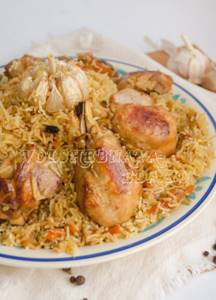
To prepare pilaf, you take quite a lot of carrots . You need carrots that retain their shape during stewing and do not fall apart; they must be cut into strips. Onions are also often added to pilaf - it adds flavor to the dish.
The most important spice for pilaf is considered to be cumin . In addition to cumin, not many spices are added - usually hot pepper, a head of garlic, and barberry. Bay leaves are not placed in pilaf.
The choice of utensils for preparing pilaf is important. Ideally, this should be a cauldron. But, you must admit, not everyone has such dishes at home. Therefore, you can cook pilaf in a wok, deep frying pan or pan with thick walls.
Rice cooking techniques may seem confusing to a beginner. But once you cook the pilaf a couple of times, you’ll be able to do it without too much fuss. So, all the ingredients need to be prepared in advance. Then the oil is heated, in which the vegetables and meat will be fried.
When the zirvak is ready, spices are introduced and rice is added. But this is not the end: as soon as the rice is stewed, the process of preparing the pilaf will continue: the pilaf is covered with a lid and allowed to ripen for half an hour, or even better, an hour. Only after this you will receive that magical and unique dish that can be called “proper pilaf”. Cooking time: about 2 hours
- 400 grams rice (basmati)
- 400-500 grams of chicken meat
- 300 grams of carrots
- 1 large onion
- 1 whole head of garlic
- 75 ml refined vegetable oil
- a set of spices for pilaf, which contains cumin, red hot pepper and barberry
- salt, black pepper - to taste
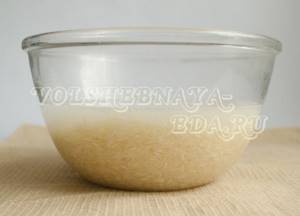
Now chop all the other ingredients. Cut the onion into half rings.
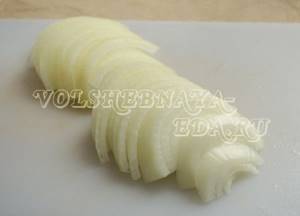
Cut the meat into large pieces.
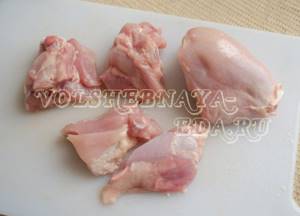
Peel the carrots and chop into strips.
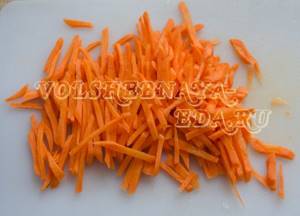
Now you can start cooking. To begin, pour the vegetable oil into a bowl and heat the oil over fairly high heat - white smoke should start coming out of it.
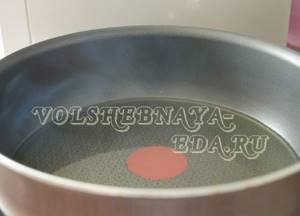
Carefully place the onion into the hot oil. It is necessary to constantly stir the onions so that they fry evenly. In just a couple of minutes it should turn rosy.
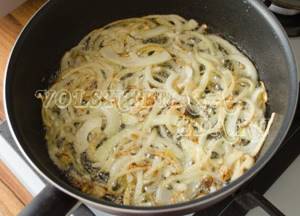
At this point, place the meat in the dish.
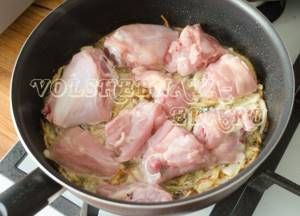
It should also begin to crust.
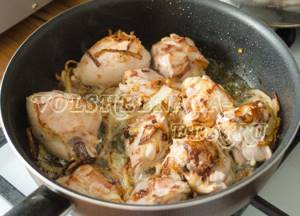
As soon as this happens, place the carrots in the dish. Stir the contents, but do it very delicately and gently.
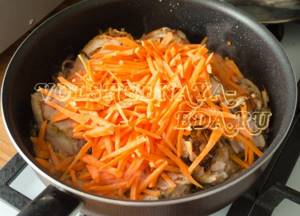
Fry everything for 5 minutes, then pour in 500 ml of water and add a whole head of garlic. This is the beginning of the final stage of preparing zirvak. Let it boil, reduce the heat to medium and simmer the zirvak
30 minutes.
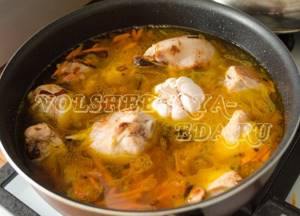
After this time, remove the garlic and add salt and spices to the zirvak.
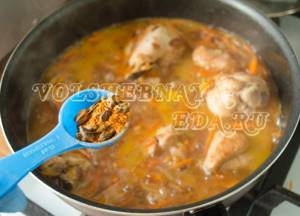
And then send the washed rice. Rice should not float in a large amount of liquid, otherwise the pilaf will not turn out crumbly. As soon as you add the rice, the heat should be reduced to minimum, but so that the liquid is still bubbling a little.
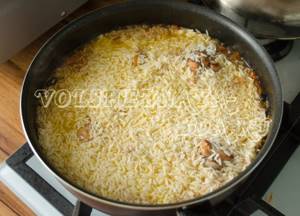
Another trick: to prevent the rice from burning during cooking, stir it as if from above, without touching the meat and vegetables at the bottom, with light stroking movements. After 10 minutes, when the rice is almost ready, form a mound out of it and place the head of garlic in the center, which was stewed in zirvak earlier.
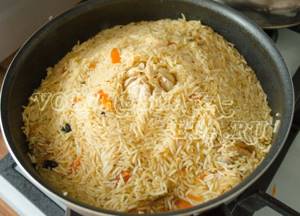
Then cover the dish with a tight lid, turn off the heat and leave to simmer for at least half an hour. And when the pilaf is finally ready, take out the garlic and all the pieces of meat, and fluff the rice itself using a slotted spoon or spatula so that it becomes airy and light.
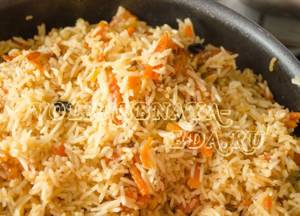
Place a mound of rice on a large dish, decorate the top with garlic, and arrange the meat beautifully around it. You can only supplement it with a vegetable salad and a cup of green tea - that’s the whole feast. Bon appetit!
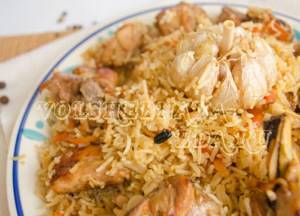
How much barberry should I add?
The proportions of ingredients are very important. If you add too much of any component, the taste of the pilaf will deteriorate. So, an excess of saffron will make the food bitter, and barberry too sour. As many variations of a dish as there are, there are so many proportions. In lamb pilaf with barberry add only 1 tablespoon of dried berries per ½ kg of zirvak and half a kilo of rice. And in the recipe with beef you need 1 kg of the main components, but only 2 teaspoons of red fruits.
But what if there is no barberry? Some argue that in this case there is no point in cooking pilaf. Others replace the berries with cranberries, dogwoods, raisins, cherry plums, prunes, and quince. And still others believe that if there is no barberry, then it is better to cook without their substitutes.
Pilaf with cumin and barberry
Residents of Asian countries love cumin because it adds a special aroma to food. It is customary to use both whole cumin grains and in powder form.
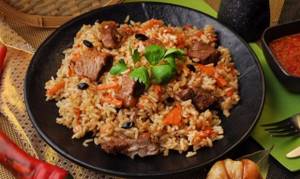
To prepare you will need:
- ½ kg beef;
- 3 medium onions;
- ½ kg of carrot roots;
- vegetable oil - 1 tbsp.;
- dried barberry – ½ tbsp. l.;
- chili pepper – 1 pod;
- rice (long-grain parboiled) – ½ kg;
- ½ tbsp. cumin;
- 2 small heads of garlic;
- salt - to taste;
- ½ tsp. coriander
- First of all, you need to rinse the rice thoroughly. Add some warm water and pour it over the cereal.
- Remove the husks from the onions and chop them into half rings.
- We peel the carrot roots and, armed with a knife, cut them into strips.
- Chop the beef into medium cubes.
- Place the cauldron on the stove and after heating, add oil.
- Place the meat pieces and cook over medium heat until golden brown.
- Add the chopped vegetables to the beef, mix and simmer for about 10 minutes.
- Season the zirvak with spices and continue simmering until the carrots soften.
Garlic
This is also not a spice, but it is an almost constant ingredient in classic pilaf. It imparts its smell and irreplaceable taste properties to the dish. Often a whole head of garlic is placed in pilaf, the roots are removed and peeled. After preparing the pilaf, the boiled garlic is eaten. Residents of Asian countries really like this garlic.
You can also add nuts to the food (although these are also not spices), which also saturate the pilaf and are themselves saturated with a special taste.
If you don’t like the components in the spices in local stores, you can select them yourself according to your own preferences. You don’t even have to mix them; you can add them to the dish separately. First, we go to the store or even to the market and buy the spices that we like best and that are best suited to pilaf with chicken. After all, the composition of spices directly depends on what kind of pilaf you plan to cook. There are subtleties here. Pilaf is seasoned with spices to add a pleasant aroma and taste. Bay leaf is placed exclusively in chicken pilaf. Not all cooks add it, but nevertheless it is a very popular ingredient.
Spices sold in stores come already prepared for use. It is important not to forget to study the components of such seasonings, because only those spices that are indicated in the recipe are used to prepare a certain type of pilaf.
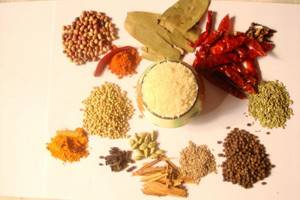
Pilaf with chicken and barberry
- Peel the vegetables and dice the onion and grate the carrots.
- Shred the meat into small pieces.
- Season a hot cauldron with oil and fry the chicken until a delicious smell spreads throughout the kitchen.

How to make your own seasoning for pilaf: recipe
Making your own pilaf seasoning couldn't be easier. To do this, you just need to mix the right spices.
So, we will need:
- Zira – 1 tsp.
- Turmeric – 1 tsp.
- Dried garlic – 1.5 tsp.
- Paprika – 1 tsp.
- Barberry – 10-20 g
- Cumin - half a tsp.
Mix all the ingredients and put them in a container in which we will store the aromatic seasoning.
Make your own seasoning for pilaf
Another recipe for pilaf seasoning:
- Zira – 1 tsp.
- Turmeric – 1.5 tsp.
- Paprika – 1.5 tsp.
- Barberry – 15 g
- Rosemary - half a tsp.
- Curry - half a tsp.
- Dried crushed tomatoes - 1.5 tbsp. l.
- Dried herbs – 2 tbsp. l.
- Raisins optional
There are a huge number of recipes according to which you can prepare seasoning for pilaf. The main thing to know is that when preparing the seasoning, the required ingredients are cumin, turmeric, barberry, garlic and pepper. You can add the rest of the ingredients at your discretion.
Pilaf is a favorite dish almost all over the world and, as we were able to see today, for good reason. Its delicious aroma and attractive appearance will not leave anyone indifferent. Stock up on the necessary ingredients, cook and delight yourself and your loved ones with delicious pilaf!
Pilaf with barberry in a slow cooker
Oddly enough, but pilaf cooked in this kitchen aid turns out no worse than in a cauldron. Required components:
- brown rice (unpolished, long grain) – ½ kg;
- half a kilo of carrots;
- 2 onions;
- ½ kg pork pulp;
- seasoning mixture for pilaf – 2 tsp;
- a small head of garlic;
- 1 tbsp. l. barberry fruit;
- half a glass of oil;
- sun-dried tomatoes – 100 g;
- saffron – ½ tsp;
- salt and freshly ground pepper to taste.
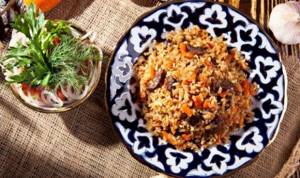
- Cut the pork flesh into medium pieces, chop the peeled vegetables: carrots into thin slices, onions into circles, and then into quarters.
- Set the multicooker to the “Frying” program, season the bowl with oil and wait for it to heat up.
- Fry the meat until golden brown, add chopped vegetables and sauté until soft.
- Cut the sun-dried tomatoes into small pieces and send them for frying, also lay out the barberries, sprinkle with saffron and seasoning, season with pepper and salt.
- Mix thoroughly and spread the rice in an even layer.
- Wash the head of garlic and immerse it in the cereal. Carefully pour boiling water, it should cover the rice by 1 cm.
- Close the lid and switch the mode to “Pilaf” or “Porridge”.
- After the signal that cooking is complete, turn on the heating program and set the time to 20 minutes.
- Remove the garlic head, mix and enjoy.
Pilaf with saffron and barberry can be prepared not only in a slow cooker, but also in a cauldron. Prepare according to the usual recipe, not forgetting to add this spice.
Uzbek pilaf with barberry
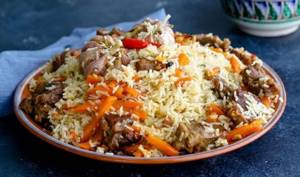
- hot pepper – 2 medium pods;
- devzir – 1 kg;
- Uzbek seasoning mixture for pilaf – 2–3 tsp;
- ¼ kg of onion;
- lamb pulp and carrots – 1 kg each;
- head of garlic – 3 pcs.;
- barberry berries – 1 tbsp. l.;
- melted fat tail fat – ¼ l;
- salt.
- Place the cast iron cauldron on the stove, and while it is heating up, peel the vegetables and chop them into thin slices. Grind the meat into medium squares.
- Pour in the melted fat and heat it thoroughly.
- Place the lamb in a bowl and fry until golden brown.
- We supplement the meat frying with chopped vegetables and simmer the mixture for about 15 minutes.
- Add water to cover the zirvak, add barberry, seasoning and salt. We also put the garlic heads and chilies into stock.
- After boiling, reduce the heat and simmer the substance for 50–60 minutes.
- After removing the garlic and pepper from the zirvak, cover it with an even layer of rice.
- Carefully pour in water; it should cover the surface by 2 cm.
- Cook with the lid closed until the liquid evaporates.
- Mix the pilaf and form a slide, in the center of which we place the previously removed garlic. Let it brew for about 40 minutes.
Traditional recipe rules can be modified by adding ingredients as desired. After all, the main thing in taste is not strict adherence to the algorithm, but your own preferences.








